Na Zhao
An Integrated Framework of Prompt Engineering and Multidimensional Knowledge Graphs for Legal Dispute Analysis
Jul 10, 2025Abstract:The rapid development of artificial intelligence has positioned large language models as fundamental components of intelligent legal systems. However, these models face significant limitations in legal dispute analysis, including insufficient legal knowledge representation, limited concept understanding, and reasoning deficiencies. This research proposes an enhanced framework integrating prompt engineering with multidimensional knowledge graphs. The framework introduces a three-stage hierarchical prompt structure comprising task definition, knowledge background, and reasoning guidance, supplemented by legal-specific reasoning templates and dynamic optimization mechanisms. A three-layer knowledge graph architecture is constructed with legal classification ontology, representation, and instance layers. Four complementary methods enable precise legal concept retrieval: direct legal norm code matching, domain-specific semantic vector similarity, ontology-based path reasoning, and specialized lexical segmentation. These components integrate with web search technology to establish a knowledge-enhanced framework for legal decision-making. Experimental results demonstrate significant performance improvements in legal dispute analysis, enabling accurate legal application analysis for complex cases while exhibiting nuanced understanding of judicial decision-making logic, providing a novel technical approach for implementing intelligent legal assistance systems.
How Do Images Align and Complement LiDAR? Towards a Harmonized Multi-modal 3D Panoptic Segmentation
May 25, 2025Abstract:LiDAR-based 3D panoptic segmentation often struggles with the inherent sparsity of data from LiDAR sensors, which makes it challenging to accurately recognize distant or small objects. Recently, a few studies have sought to overcome this challenge by integrating LiDAR inputs with camera images, leveraging the rich and dense texture information provided by the latter. While these approaches have shown promising results, they still face challenges, such as misalignment during data augmentation and the reliance on post-processing steps. To address these issues, we propose Image-Assists-LiDAR (IAL), a novel multi-modal 3D panoptic segmentation framework. In IAL, we first introduce a modality-synchronized data augmentation strategy, PieAug, to ensure alignment between LiDAR and image inputs from the start. Next, we adopt a transformer decoder to directly predict panoptic segmentation results. To effectively fuse LiDAR and image features into tokens for the decoder, we design a Geometric-guided Token Fusion (GTF) module. Additionally, we leverage the complementary strengths of each modality as priors for query initialization through a Prior-based Query Generation (PQG) module, enhancing the decoder's ability to generate accurate instance masks. Our IAL framework achieves state-of-the-art performance compared to previous multi-modal 3D panoptic segmentation methods on two widely used benchmarks. Code and models are publicly available at <https://github.com/IMPL-Lab/IAL.git>.
Uncertainty Meets Diversity: A Comprehensive Active Learning Framework for Indoor 3D Object Detection
Mar 20, 2025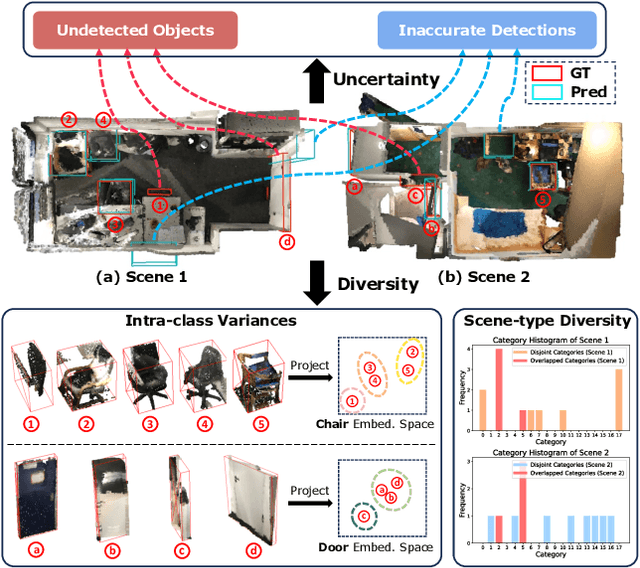

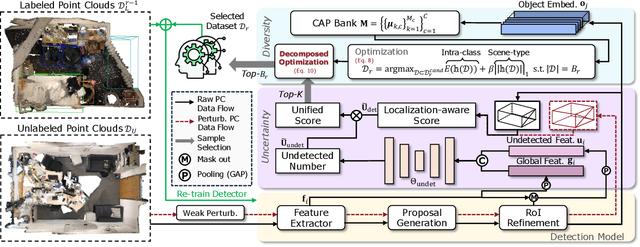
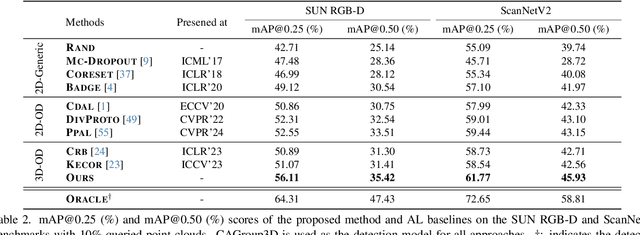
Abstract:Active learning has emerged as a promising approach to reduce the substantial annotation burden in 3D object detection tasks, spurring several initiatives in outdoor environments. However, its application in indoor environments remains unexplored. Compared to outdoor 3D datasets, indoor datasets face significant challenges, including fewer training samples per class, a greater number of classes, more severe class imbalance, and more diverse scene types and intra-class variances. This paper presents the first study on active learning for indoor 3D object detection, where we propose a novel framework tailored for this task. Our method incorporates two key criteria - uncertainty and diversity - to actively select the most ambiguous and informative unlabeled samples for annotation. The uncertainty criterion accounts for both inaccurate detections and undetected objects, ensuring that the most ambiguous samples are prioritized. Meanwhile, the diversity criterion is formulated as a joint optimization problem that maximizes the diversity of both object class distributions and scene types, using a new Class-aware Adaptive Prototype (CAP) bank. The CAP bank dynamically allocates representative prototypes to each class, helping to capture varying intra-class diversity across different categories. We evaluate our method on SUN RGB-D and ScanNetV2, where it outperforms baselines by a significant margin, achieving over 85% of fully-supervised performance with just 10% of the annotation budget.
Robust Multi-View Learning via Representation Fusion of Sample-Level Attention and Alignment of Simulated Perturbation
Mar 06, 2025



Abstract:Recently, multi-view learning (MVL) has garnered significant attention due to its ability to fuse discriminative information from multiple views. However, real-world multi-view datasets are often heterogeneous and imperfect, which usually makes MVL methods designed for specific combinations of views lack application potential and limits their effectiveness. To address this issue, we propose a novel robust MVL method (namely RML) with simultaneous representation fusion and alignment. Specifically, we introduce a simple yet effective multi-view transformer fusion network where we transform heterogeneous multi-view data into homogeneous word embeddings, and then integrate multiple views by the sample-level attention mechanism to obtain a fused representation. Furthermore, we propose a simulated perturbation based multi-view contrastive learning framework that dynamically generates the noise and unusable perturbations for simulating imperfect data conditions. The simulated noisy and unusable data obtain two distinct fused representations, and we utilize contrastive learning to align them for learning discriminative and robust representations. Our RML is self-supervised and can also be applied for downstream tasks as a regularization. In experiments, we employ it in unsupervised multi-view clustering, noise-label classification, and as a plug-and-play module for cross-modal hashing retrieval. Extensive comparison experiments and ablation studies validate the effectiveness of RML.
MotionLab: Unified Human Motion Generation and Editing via the Motion-Condition-Motion Paradigm
Feb 06, 2025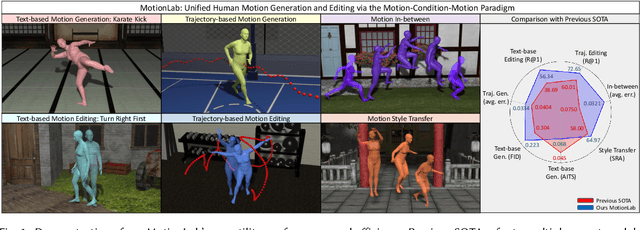



Abstract:Human motion generation and editing are key components of computer graphics and vision. However, current approaches in this field tend to offer isolated solutions tailored to specific tasks, which can be inefficient and impractical for real-world applications. While some efforts have aimed to unify motion-related tasks, these methods simply use different modalities as conditions to guide motion generation. Consequently, they lack editing capabilities, fine-grained control, and fail to facilitate knowledge sharing across tasks. To address these limitations and provide a versatile, unified framework capable of handling both human motion generation and editing, we introduce a novel paradigm: Motion-Condition-Motion, which enables the unified formulation of diverse tasks with three concepts: source motion, condition, and target motion. Based on this paradigm, we propose a unified framework, MotionLab, which incorporates rectified flows to learn the mapping from source motion to target motion, guided by the specified conditions. In MotionLab, we introduce the 1) MotionFlow Transformer to enhance conditional generation and editing without task-specific modules; 2) Aligned Rotational Position Encoding} to guarantee the time synchronization between source motion and target motion; 3) Task Specified Instruction Modulation; and 4) Motion Curriculum Learning for effective multi-task learning and knowledge sharing across tasks. Notably, our MotionLab demonstrates promising generalization capabilities and inference efficiency across multiple benchmarks for human motion. Our code and additional video results are available at: https://diouo.github.io/motionlab.github.io/.
AugRefer: Advancing 3D Visual Grounding via Cross-Modal Augmentation and Spatial Relation-based Referring
Jan 16, 2025



Abstract:3D visual grounding (3DVG), which aims to correlate a natural language description with the target object within a 3D scene, is a significant yet challenging task. Despite recent advancements in this domain, existing approaches commonly encounter a shortage: a limited amount and diversity of text3D pairs available for training. Moreover, they fall short in effectively leveraging different contextual clues (e.g., rich spatial relations within the 3D visual space) for grounding. To address these limitations, we propose AugRefer, a novel approach for advancing 3D visual grounding. AugRefer introduces cross-modal augmentation designed to extensively generate diverse text-3D pairs by placing objects into 3D scenes and creating accurate and semantically rich descriptions using foundation models. Notably, the resulting pairs can be utilized by any existing 3DVG methods for enriching their training data. Additionally, AugRefer presents a language-spatial adaptive decoder that effectively adapts the potential referring objects based on the language description and various 3D spatial relations. Extensive experiments on three benchmark datasets clearly validate the effectiveness of AugRefer.
Tuning-Free Long Video Generation via Global-Local Collaborative Diffusion
Jan 08, 2025



Abstract:Creating high-fidelity, coherent long videos is a sought-after aspiration. While recent video diffusion models have shown promising potential, they still grapple with spatiotemporal inconsistencies and high computational resource demands. We propose GLC-Diffusion, a tuning-free method for long video generation. It models the long video denoising process by establishing denoising trajectories through Global-Local Collaborative Denoising to ensure overall content consistency and temporal coherence between frames. Additionally, we introduce a Noise Reinitialization strategy which combines local noise shuffling with frequency fusion to improve global content consistency and visual diversity. Further, we propose a Video Motion Consistency Refinement (VMCR) module that computes the gradient of pixel-wise and frequency-wise losses to enhance visual consistency and temporal smoothness. Extensive experiments, including quantitative and qualitative evaluations on videos of varying lengths (\textit{e.g.}, 3\times and 6\times longer), demonstrate that our method effectively integrates with existing video diffusion models, producing coherent, high-fidelity long videos superior to previous approaches.
A Closer Look on Gender Stereotypes in Movie Recommender Systems and Their Implications with Privacy
Jan 08, 2025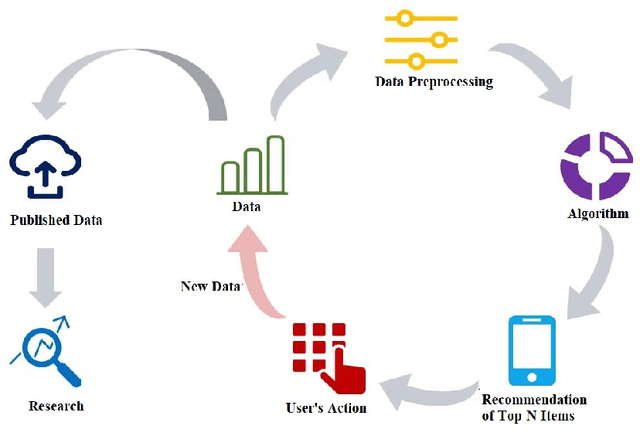

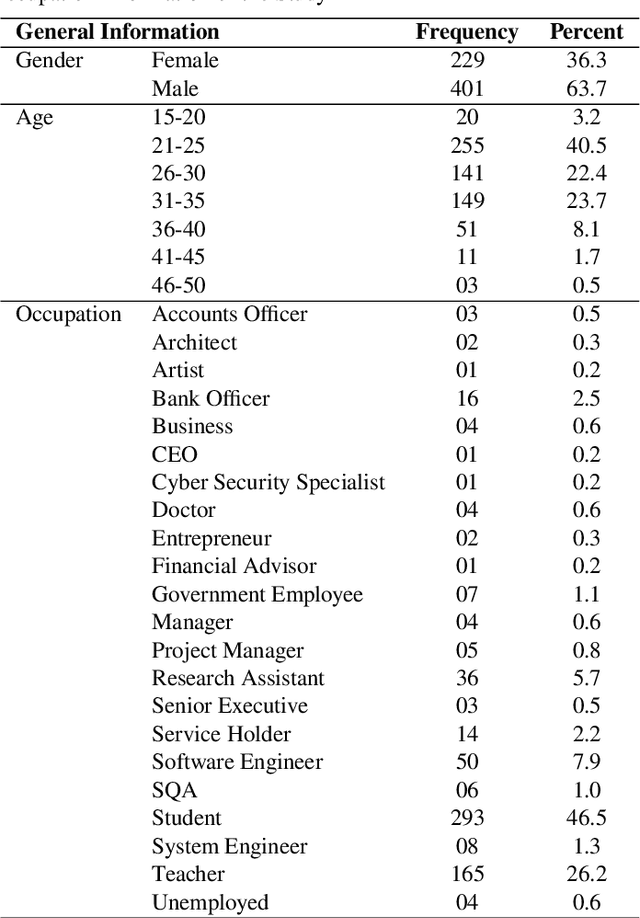
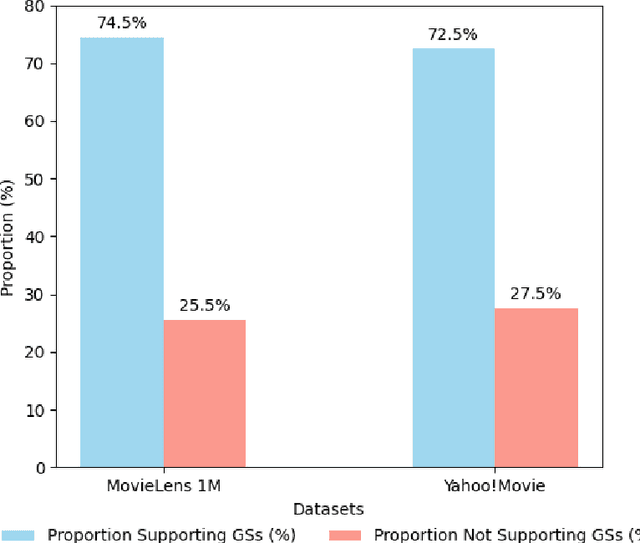
Abstract:The movie recommender system typically leverages user feedback to provide personalized recommendations that align with user preferences and increase business revenue. This study investigates the impact of gender stereotypes on such systems through a specific attack scenario. In this scenario, an attacker determines users' gender, a private attribute, by exploiting gender stereotypes about movie preferences and analyzing users' feedback data, which is either publicly available or observed within the system. The study consists of two phases. In the first phase, a user study involving 630 participants identified gender stereotypes associated with movie genres, which often influence viewing choices. In the second phase, four inference algorithms were applied to detect gender stereotypes by combining the findings from the first phase with users' feedback data. Results showed that these algorithms performed more effectively than relying solely on feedback data for gender inference. Additionally, we quantified the extent of gender stereotypes to evaluate their broader impact on digital computational science. The latter part of the study utilized two major movie recommender datasets: MovieLens 1M and Yahoo!Movie. Detailed experimental information is available on our GitHub repository: https://github.com/fr-iit/GSMRS
Provably Secure Robust Image Steganography via Cross-Modal Error Correction
Dec 15, 2024Abstract:The rapid development of image generation models has facilitated the widespread dissemination of generated images on social networks, creating favorable conditions for provably secure image steganography. However, existing methods face issues such as low quality of generated images and lack of semantic control in the generation process. To leverage provably secure steganography with more effective and high-performance image generation models, and to ensure that stego images can accurately extract secret messages even after being uploaded to social networks and subjected to lossy processing such as JPEG compression, we propose a high-quality, provably secure, and robust image steganography method based on state-of-the-art autoregressive (AR) image generation models using Vector-Quantized (VQ) tokenizers. Additionally, we employ a cross-modal error-correction framework that generates stego text from stego images to aid in restoring lossy images, ultimately enabling the extraction of secret messages embedded within the images. Extensive experiments have demonstrated that the proposed method provides advantages in stego quality, embedding capacity, and robustness, while ensuring provable undetectability.
Domain Expansion and Boundary Growth for Open-Set Single-Source Domain Generalization
Nov 05, 2024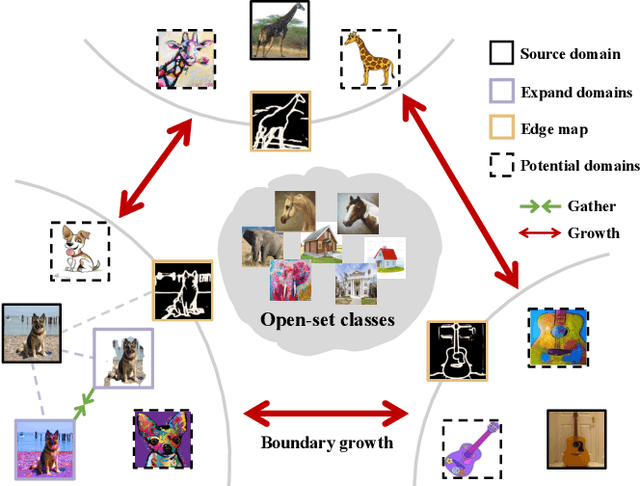
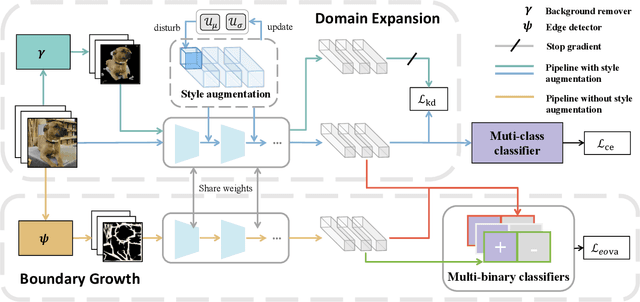

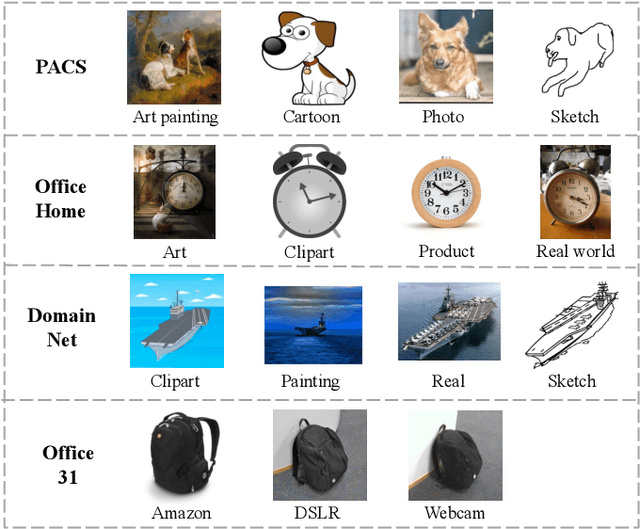
Abstract:Open-set single-source domain generalization aims to use a single-source domain to learn a robust model that can be generalized to unknown target domains with both domain shifts and label shifts. The scarcity of the source domain and the unknown data distribution of the target domain pose a great challenge for domain-invariant feature learning and unknown class recognition. In this paper, we propose a novel learning approach based on domain expansion and boundary growth to expand the scarce source samples and enlarge the boundaries across the known classes that indirectly broaden the boundary between the known and unknown classes. Specifically, we achieve domain expansion by employing both background suppression and style augmentation on the source data to synthesize new samples. Then we force the model to distill consistent knowledge from the synthesized samples so that the model can learn domain-invariant information. Furthermore, we realize boundary growth across classes by using edge maps as an additional modality of samples when training multi-binary classifiers. In this way, it enlarges the boundary between the inliers and outliers, and consequently improves the unknown class recognition during open-set generalization. Extensive experiments show that our approach can achieve significant improvements and reach state-of-the-art performance on several cross-domain image classification datasets.
 Add to Chrome
Add to Chrome Add to Firefox
Add to Firefox Add to Edge
Add to Edge